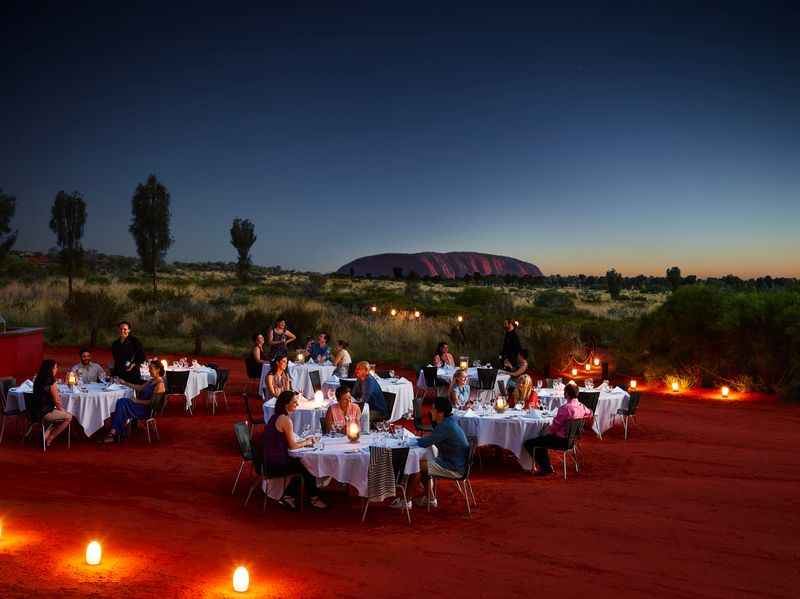Complete Guide to Experiencing Uluṟu-Kata Tjuṯa National Park | 2024 (with Photos)

This guide will take you through my recent journey into the heart of Australia's Red Centre, where Uluṟu, a monumental sandstone formation, stands as a testament to the timeless beauty and deep cultural significance of the Australian Aboriginal land.
My name is James, and I am the founder of Travel-Lingual, a platform dedicated to exploring the world's cultures and landscapes through the eyes of those who want to understand more about them through guided tours and experiences.
In this article, I'll take you through the significance of the region, the tours and activities available at Uluṟu-Kata Tjuṯa National Park, and my experience visiting this part of Central Australia in the country’s spectacular Northern Territory.
Uluṟu-Kata Tjuṯa National Park is a sacred place, deeply ingrained in Australian Indigenous culture and spirituality, offering a unique glimpse into the country's rich cultural heritage.
Most Recommended Thing to Do
Uluru Base Walk
Top Choice Hotel
Sails in the Desert
Our Top Choice Restaurant
Sounds good! Here is the name: Tali Wiru.
Our Top Choice Bar for Nightlife
Outback Pioneer Hotel & Lodge Bar
Best Time to Visit
Best Time To Visit Uluru: cool winter months.
Average Temperature
The average temperature in Uluru, Australia is hot.
Transportation Options
Bus, shuttle, car rental, bicycle – no public transport.
Average Cost ($, $$, $$$)
$$
My Top Recommendation
In Uluru, I recommend waking up early to witness the vibrant colors of the sunrise painting the majestic red rock formation, followed by a serene walk around the base to marvel at the intricate details of its ancient engravings and caves.
For a truly immersive experience, indulge in a unique dining under the mesmerizing starlit sky, savoring regional dishes while listening to the soothing sounds of didgeridoos, creating unforgettable moments amidst the spiritual energy of Uluru.
What You'll Need to Bring
-
Sunscreen, hat, and sunglasses
-
Comfortable walking shoes
-
Water bottle and snacks
-
Camera or smartphone for photos
-
Layered clothing for varying temperatures
-
Insect repellent
What Not to Miss
- Uluru: Sunrise and Sunset Viewing
- Kata Tjuta: Valley of the Winds hike
What to Avoid
- Avoid climbing Uluru, as it is not permitted and disrespectful to the local Anangu people.
- Avoid picking plants or disturbing the wildlife in the area.
Table of Contents
Visiting Uluṟu-Kata Tjuṯa National Park
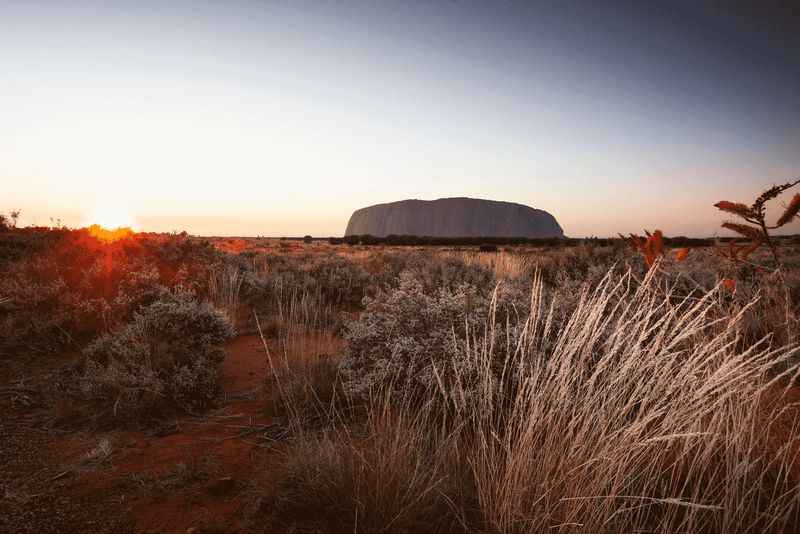
Uluṟu-Kata Tjuṯa National Park is a World Heritage site that encompasses both Uluṟu and the 36 domes of Kata Tjuṯa.
It is a unique and iconic region, home to Anangu - the Traditional Owners of these lands - as well as a variety of animal life, native grasses, and rock formations that have shaped the landscape for hundreds of millions of years.
The park is run in joint management between the Aṉangu Traditional Owners and Parks Australia, reflecting a partnership that honors the cultural practices and knowledge of the Indigenous people while protecting the park's unique ecosystem.
Furthermore, the park is a testament to the successful blending of Indigenous knowledge and modern conservation science, ensuring the protection of this sacred landscape for future generations.
The cultural landscape here is of great significance for the way it is perceived as the creation of Mala, Lungkata, Itjaritjari, Liru and Kuniya - these are heroic ancestral beings that form part of Tjukurpa’ or ‘creation stories’. Tjukurpa is the cultural law of the land, similar to the concept of ‘Dreamtime’ which is used in other parts of Australia.
Visitors are required to purchase a park pass to gain entry, which contributes to conservation efforts and the maintenance of visitor facilities.
Understanding Uluṟu
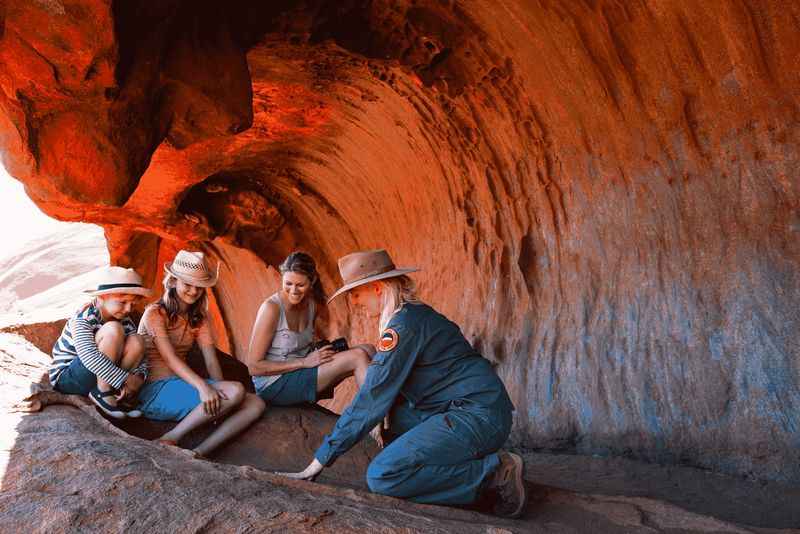
Uluṟu, the majestic red rock rising from the heart of Australia's Red Centre, has long captivated the imagination of travelers from around the globe. Measuring 348m (1,140ft) high and 9.5km (6mi) in circumference, it is the largest sandstone monolith in the world.
My journey to Uluṟu was driven by a desire to witness its grandeur firsthand and to understand the profound connection between the land and its Indigenous peoples.
This guide aims to share everything you need to know about Uluṟu, from its cultural importance to the myriad experiences it offers visitors.
It's important for visitors to recognize that Uluṟu is a living cultural landscape. Every crevice, cave, and natural feature of Uluṟu has a story, contributing to its status as a UNESCO World Heritage Site for both its natural and cultural values.
Exploring Uluṟu: A Journey Around the Sacred Monolith

During our visit, we purchased tickets for the hop-on-hop-off bus service, which allowed us to watch the sunrise over Uluṟu from within the National Park. If you want to do this, brace yourself for a 04:50 AM pickup from your accommodation within the resort (more on this shortly).
After sunrise, visitors are driven to the base of Uluṟu, from where you can start the Base Walk.
If you’re visiting in summer, starting your walk before 7AM means you can complete it before the unbearable midday heat of the Northern Territory kicks in. If you visit between April to October, you can expect comfortable temperatures of around 25 degrees celsius.
Walking around the base of Uluṟu is an experience that is as spiritual as it is physical. The 10.6 km loop takes you through diverse landscapes, from open plains to dense bush, and past ancient rock art sites.
The sheer size of Uluṟu is humbling, and with every step, you're reminded of the deep cultural significance it holds for the Aṉangu people. Signs along the path share stories of Tjukurpa, giving context to the formations and features you see.
Opting for a guided tour enhances the experience for some visitors, as knowledgeable guides share stories, point out hidden details, and explain the cultural taboos and significance of different parts of Uluṟu.
These tours are not just educational; they are an opportunity to connect with the land in a way that respects its traditional custodians and their ongoing connection to Country.
That said, we chose to walk alone and do so at our own pace. Note that there are other walks you can opt for if you are looking for a shorter trail. With a hop-on-hop-off bus, you can ask the driver to drop you at the specific location you require to start your walk.
One of the most popular short walks is the Mala Walk, which encompasses the Mutitjulu Waterhole - a must-see in the dry red dirt of the outback.
Kata Tjuṯa: Discovering the Many Heads
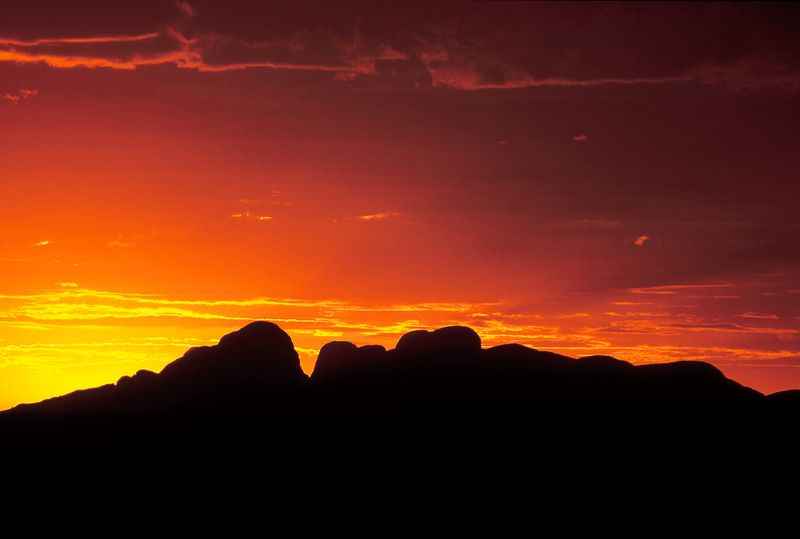
Kata Tjuṯa, also known as the Olgas, is a group of large, ancient rock formations about 30 km west of Uluṟu - or a 45 minute drive.
While Uluṟu might be the star attraction, Kata Tjuṯa offers a different, but equally awe-inspiring, experience.
The site is sacred to Aṉangu men, with many paths closed to the public to preserve their spiritual integrity. However, walking trails like the Valley of the Winds and the Walpa Gorge Walk provide visitors with breathtaking views of the domes and the surrounding landscape.
Visiting Kata Tjuṯa, you're struck by the silence and the sense of ancient presence that envelops these formations. We opted out of the sunset viewing of Kata Tjuṯa due to time constraints, instead choosing the sunrise experience. We then walked the Walpa Gorge Walk.
The scale of Kata Tjuṯa, its geological complexity, and the changing colors at sunrise and sunset make it a must-visit for anyone traveling to the national park.
Together, Uluṟu and Kata Tjuṯa form the heart of the Uluṟu-Kata Tjuṯa National Park, offering visitors a profound insight into the natural beauty and cultural depth of Australia's Red Centre.
Whether you're exploring the base of Uluṟu or wandering among the domes of Kata Tjuṯa, the experiences here are a reminder of the enduring connection between the land and its traditional custodians.
I strongly recommend that you visit Kata Tjuṯa for sunrise or sunset. The view is simply stunning and highlights why this part of Australia is such a special place.
Experiencing the Field of Light at Uluṟu

During your time visiting Uluru, there are numerous daytime and evening experiences on offer via the main accommodation provider in the area, Ayers Rock Resort.
I was fortunate enough to experience one of the most popular tours, known as the Field of Light.
This is an art installation by light artist Bruce Munro. The Field of Light experience is as practical as it is breathtaking. Walking through this vast installation, you're not just observing; you're part of a living canvas where art and the environment converge.
The solar-powered lights ensure the exhibit's footprint is minimal, highlighting a commitment to sustainability that's crucial in such a pristine setting. For visitors, this means enjoying an awe-inspiring spectacle without compromising the sacredness of Uluṟu.
We arrived at the Field of Light one hour before sunset, and were treated to canapés, sparkling wine, beer, and soft drinks, while overlooking Uluṟu's changing colors at sunset.
After sunset, our guide provided us with an explanation about the experience, before leading us into the Field of Light.
For the purpose of preserving the uniqueness of this experience, I have not included photos of the Field of Light, although you are permitted to take pictures during the tour.
Wintjiri Wiṟu
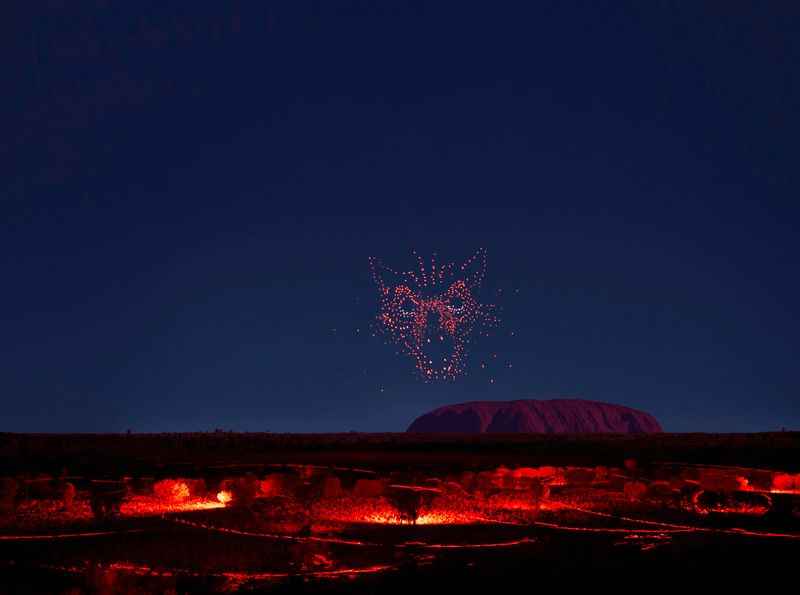
For a more intimate and exclusive experience, Wintjiri Wiṟu (meaning beautiful view) offers a luxurious dining experience with unparalleled views of Uluṟu as the sun sets.
The Sunset Dinner is the premium offering combines exquisite Australian cuisine with the finest wines, set against the backdrop of the setting sun over Uluṟu.
As you dine, the changing colors of Uluṟu and the vast, starlit sky create a magical atmosphere, making it a perfect complement to your visit to the Field of Light.
The Wintjiri Wiṟu experience is more than a meal; it's an opportunity to immerse yourself in the beauty of the desert while enjoying the company of a small, select group of fellow travelers.
You take your seat in the open-air desert theater set upon a dune top. As darkness falls, choreographed drones, lasers and light projections will light up the desert sky in a modern, artistic expression of an ancient Anangu story.
It’s a chance to witness ancient Tjukurpa brought to life like never before with ground-breaking technology. You’ll feel a powerful connection to Country as you listen to a traditional Inma soundtrack and narration in the local Pitjantjatjara language, and immerse yourself in a living story.
The attention to detail, from the choice of ingredients to the storytelling of the hosts, adds layers of enjoyment to the experience, offering a deeper connection to the land and its stories.
Both the Field of Light and Wintjiri Wiṟu showcase the unique blend of natural beauty, art, and culture that Uluṟu offers. For this reason, it's worth taking part in these experiences, rather than just visiting the National Park during your time here.
You can choose to experience Wintjiri Wiru in a number of ways - the full Sunset Dinner experience, or the condensed Twilight or After Dark experiences.
Planning Your Visit to Uluṟu Kata Tjuṯa National Park
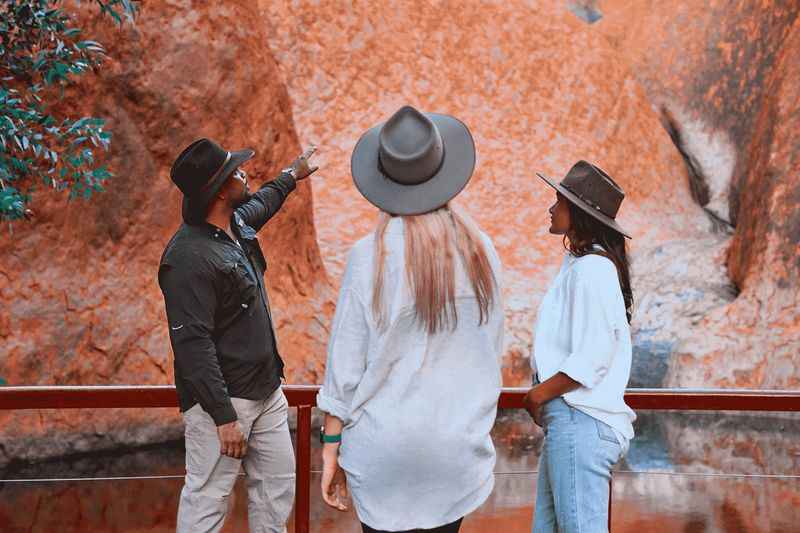
A visit to Uluṟu requires some planning to make the most of the experience.
Entry to Uluṟu-Kata Tjuṯa National Park requires a pass, which can be purchased online and before any of your tours start. Be sure to purchase this pass, or you will not be able to enter the park under any circumstances.
You should consider staying at least two to three days to fully immerse yourself in the natural beauty and cultural significance of the area.
Prior to your visit to this place, educating yourself about the cultural significance of Uluṟu and the surrounding land is essential.
Try to engage with cultural tours led by Indigenous guides, and gain invaluable insights into the traditional lore, flora, fauna, and the Aṉangu way of life. These experiences will only enrich your visit but also support the local Indigenous community.
As you prepare for your journey to Uluṟu, remember that you're about to enter a place that is as spiritually significant as it is naturally stunning.
This guide will help you navigate your visit with respect and appreciation for one of Australia's most iconic landmarks, ensuring a memorable and meaningful experience.
When to Visit Uluṟu & How to Get There
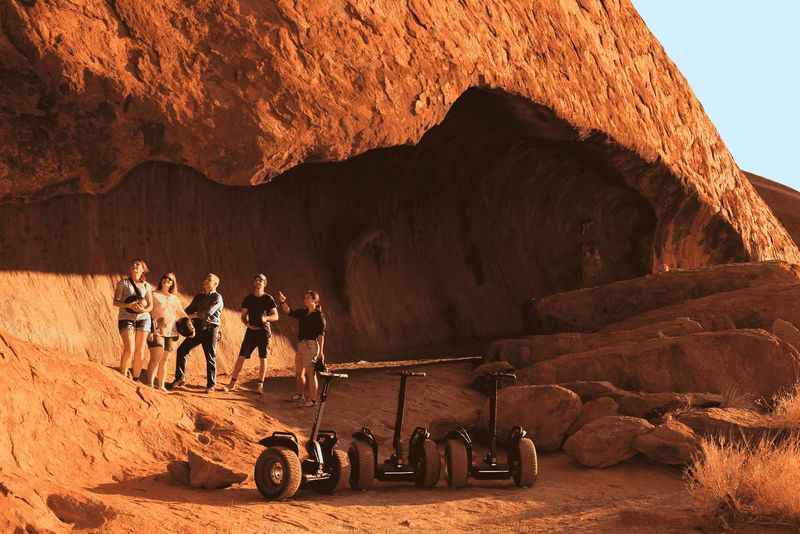
Choosing the right time to visit Uluṟu is crucial for an enjoyable experience. The region experiences extreme temperatures, with summer months (December to February) seeing daytime temperatures often exceeding 35°C (95°F).
Generally, the best time to visit is during the cooler months from April/May to October/September, when temperatures are more moderate, making outdoor activities and exploration more comfortable.
There are convenient flight connections to Ayers Rock Airport from Sydney, Melbourne, Brisbane and Cairns.
This scenic flight provides a beautiful bird's eye view of Uluṟu, Kata Tjuṯa and Mt Conner, which is the third in the row of rock formations. Alternatively, you may arrive from Alice Springs (by car) if you have chosen to explore more of the Northern Territory beforehand.
Conveniently, Ayers Rock Resort provides a free shuttle service from the airport to any accommodation within the resort, and it’s a short 10 minute drive.
Before arriving, be sure to familiarize yourself with the cultural practices and restrictions in place to protect Uluṟu's sacred sites.
Photography is restricted in certain areas to preserve the spiritual significance of the rock's features. Respecting these guidelines is paramount to honoring the Aṉangu's cultural beliefs and their generosity in sharing their homeland with visitors.
Where to Stay in Uluṟu: Accommodation Options
When visiting Uluṟu, you have a mix of accommodation options available to suit all budgets.
The accommodations in and around Uluṟu cater to a range of preferences, from the luxurious to the budget-friendly, each offering unique perspectives on this spectacular natural wonder.
I'll take you through some of these in the following section of this guide.
Ayers Rock Resort: A Hub for Uluṟu Visitors
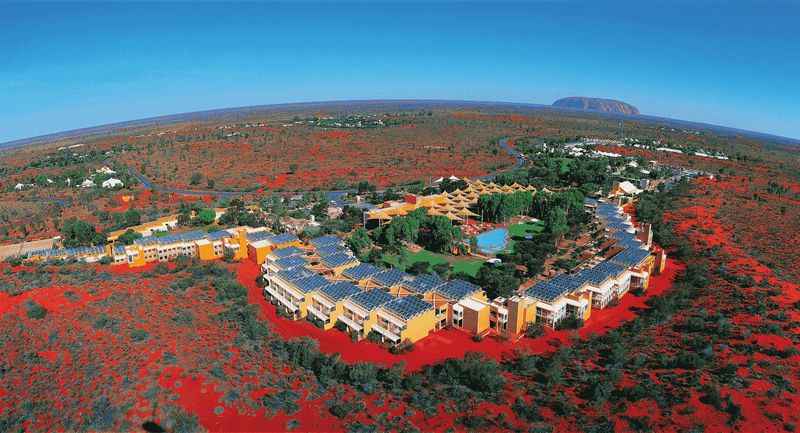
Ayers Rock Resort is the primary accommodation hub for visitors to Uluṟu, offering a variety of six different lodging options to suit different budgets and preferences.
From the 5-star Sails in the Desert hotel, known for its luxurious amenities and Aboriginal art collections, to the recently refurbished 3-star Outback Hotel & Lodge, there's something for everyone.
The resort also includes self-contained accommodation, a campground for those who prefer to sleep under the stars.
It’s worth noting that the resort is not just about accommodations; it's a center for cultural activities and tours, providing guests with opportunities to learn about Aṉangu culture, participate in dot painting workshops, and enjoy guided bush tucker walks through the expansive native gardens.
Dining options at the resort range from casual cafes to fine dining restaurants, where you can taste contemporary Australian cuisine infused with native flavors.
Below, you will find a list of accommodation options.
1. Sails in the Desert: Luxury at the Heart of the Desert

As the premium hotel at Ayers Rock Resort, Sails in the Desert offers luxurious accommodations with a beautiful swimming pool, spa, and a gallery showcasing Indigenous art.
Rooms are elegantly designed, blending modern comfort with Indigenous culture, making it an exquisite desert oasis.
2. Desert Gardens Hotel
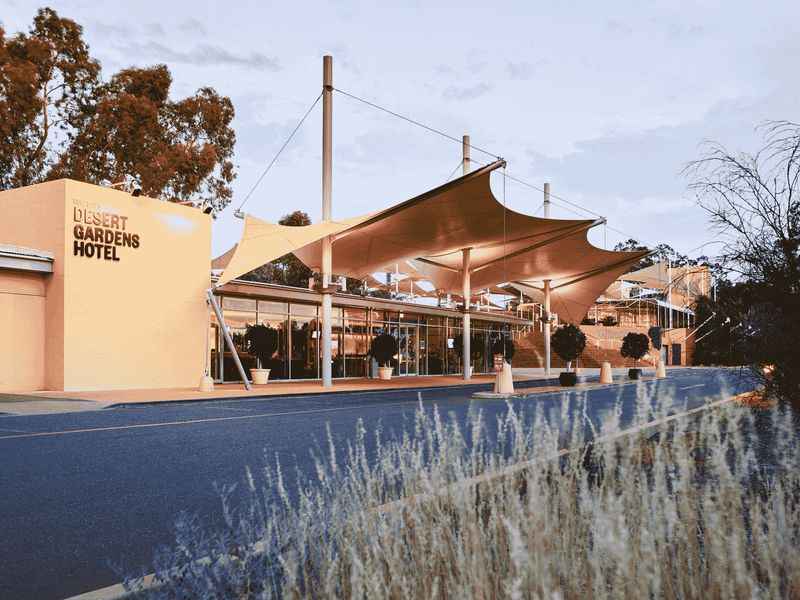
Set amidst native gardens, the 4-star Desert Gardens Hotel provides a range of accommodations from shaded poolside rooms to deluxe rooms with stunning views of Uluṟu.
It's a peaceful retreat that combines comfort with the natural beauty of the Australian outback, ideal for those seeking tranquility and convenience.
3. Emu Walk Apartments

Perfect for families or groups, 4-star Emu Walk Apartments offer self-contained 1 and 2-bedroom apartments with full kitchens and spacious living areas.
Located just minutes from the resort center, it combines home comforts with easy access to all of Ayers Rock Resort's facilities and tours.
4. Outback Hotel & Lodge

Offering both hotel and hostel-style accommodations, the 3-star Outback Hotel & Lodge is the go-to choice for budget-conscious travelers.
It has a friendly, bustling atmosphere with a BBQ and entertainment area where guests can cook their own meals and mingle.
5. The Lost Camel Hotel

The Lost Camel Hotel at Ayers Rock is a contemporary, boutique-style hotel offering a stylish and comfortable base for exploring the Uluru region.
With its modern furnishings and vibrant interiors, the 3-star property provides a unique contrast to the rugged desert surroundings, making it an ideal choice for travelers seeking a chic desert stay.
We stayed at this property during our time here, and we were very comfortable.
Embracing the Spirit of Uluṟu
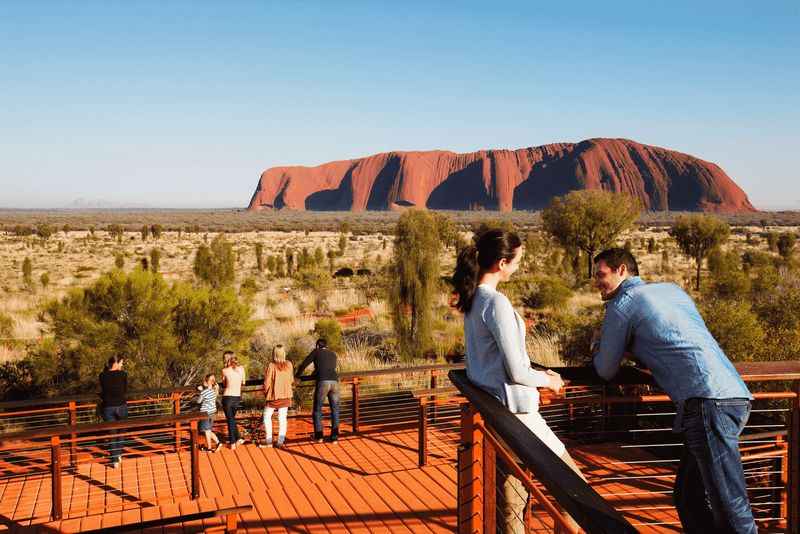
No matter where you choose to stay, the accommodations in Uluṟu are designed to enhance your connection to this sacred place.
From luxury resorts to camping under the vast outback sky, each option offers a unique way to experience the magic of Uluṟu, become familiar with the Anangu people, and try local bush foods.
Ayers Rock Resort and Sails in the Desert, in particular, provide not just a place to sleep but a comprehensive experience that includes cultural enrichment, comfort, and convenience, making your visit to Uluṟu as memorable and meaningful as possible.
Choosing the right accommodation in Uluṟu allows you to immerse yourself in the natural beauty and cultural significance of the area, ensuring that your stay is not just a visit but a journey into the heart of Australia's Red Centre and its most recognisable landmarks.
Visit the Cultural Centre or Learn About Indigenous Activities

Within the National Park, a short 2km walk from the end of the Uluṟu base walk, you will find the Cultural Centre. I believe this is a must-visit for any visitors to the park.
Here, you can refresh and rehydrate after your walk around Uluṟu, and wait for your hop-on-hop-off bus pick up (if you have paid for this service).
Arriving at the Cultural Centre prior to pick up enables you to learn more about the Anangu people, as well as observe cultural presentations.
Here you can also discover and purchase unique and original Maruku arts from the several art galleries, and hear aboriginal stories firsthand.
In addition to the cultural center, Voyages provide free access to daily activities and demonstrations, where guests can learn more about indigenous culture from guides.
Travel to Uluṟu: Tips and Recommendations

Below, you will find some travel tips to help you with your trip to this special place.
Walk Around the Base of Uluṟu
The Uluṟu base walk is a must-do for any visitor, and I strongly encourage this walk if you are fit enough.
The walk provides a comprehensive view of the rock's vastness, iconic rock formations, and allows you to see ancient Aboriginal rock paintings and natural features up close.
Throughout the walk, placards provide visitors with cultural and historical context regarding Angu culture, the connection to animal life that the original occupants of this land had, and the cultural practices that were carried out for tens of thousands of years preceding the arrival of Europeans.
In Summer - Bring a Fly Net!
I cannot emphasize this point enough. Bring a fly net with you to the National Park during the warmer months. If you forget, you can purchase one within the resort.
This part of Australia is teeming with flies during the Summer months, which can make your experience unpleasant if you are not prepared.
Experience the Field of Light
As listed above, Bruce Munro's art installation is a once-in-a-lifetime experience, illuminating the desert with thousands of lights. It's a perfect example of how art can enhance and respect the natural environment.
This lighting experience is expected to last only until 2027, so be sure to book your tickets if you visit Uluṟu before this time.
Dine Under the Stars
Whether it's a luxurious dinner at Wintjiri Wiṟu or a more casual outdoor dining experience, eating under the outback sky is unforgettable. The combination of bush tucker-inspired delicacies paired with fine Australian wine and the vast, starlit sky is magical.
Discover Stories in the Sky
The cultural storytelling experience that is Wintjiri Wiru is award-winning and world-renowned - it’s the world’s largest ongoing drone show and there is simply nothing else like it.
Explore Kata Tjuṯa
Often overshadowed by Uluṟu, Kata Tjuṯa is equally majestic.
The Valley of the Winds walk is particularly spectacular, offering breathtaking views and a deep connection with the ancient landscape.
Take a Sunrise and Sunset Tour
Witnessing the changing colors of Uluṟu and Kata Tjuṯa at dawn and dusk is a highlight. Each moment is unique, reflecting the area's profound beauty and tranquility.
Experience a Sunrise & Sunset Camel Tour
Sunrise and Sunset Camel Tours run daily from Uluru Camel Farm.
Making the Most of Your Trip to Uluṟu Kata Tjuṯa National Park

Whichever of the National Parks you are planning to visit when you come to Central Australia, there are a number of travel recommendations you should know.
Book Tours in Advance
Many experiences, especially those that are guided or offer unique insights into Aṉangu culture, can fill up quickly. Booking ahead ensures you won't miss out.
What to Pack
The desert climate means wide temperature variations. Bring layers for the cool mornings and evenings, and light clothing for the daytime heat. Sun protection is essential, as is a good supply of water.
In addition, bring a fly net to wear whenever you are outside in the summer months. The extreme heat and waterholes make this area a breeding ground for flies.
Respect Sacred Sites
Uluṟu and Kata Tjuṯa are deeply significant to Aṉangu. Follow all signage and guidelines regarding photography and access to certain areas. Listening and adhering to these rules is a sign of respect for the Traditional Owners.
Note that due to this, as well as for safety reasons, it is no longer possible to climb Uluṟu. There is no exception to this rule, which was implemented in October 2019. Please do not expect to be able to climb.
Stay Hydrated and Protected
The dry climate can take a toll on your body. Drink plenty of water, use sunscreen, and wear a hat and sunglasses to protect yourself from the sun.
During summer, remember that the best time to walk in the park is from sunrise to mid-morning, or at sunset. In the cooler months, you can expect to be able to explore throughout the day.
Cultural Sensitivity
Take time to learn about the Aṉangu culture and the history of the area. Participating in cultural tours or activities can enrich your understanding and appreciation of this unique place.
Remember, a visit to Uluṟu is more than just a trip; it's an opportunity to connect with ancient traditions, witness spectacular natural beauty, and reflect on the significance of this sacred part of Australia.
With careful planning and an open heart, your journey to Uluṟu can be an enriching experience that stays with you long after you've returned home.
Other Places to Visit in Northern Territory

Exploring Uluṟu-Kata Tjuṯa National Park is an unforgettable experience, but the Northern Territory has much more to offer.
Beyond the iconic red rock, this vast region is home to diverse landscapes, rich cultural heritage, and unique natural wonders.
From the rugged gorges of Watarrka National Park to the vibrant cultural life of Alice Springs and the breathtaking formations of Kings Canyon, each destination offers its own unique set of experiences.
Here are a few must-visit places that will enrich your journey through Australia's heartland.
Watarrka National Park
Home to the majestic Kings Canyon, Watarrka National Park offers breathtaking views, deep gorges, and ancient Luritja Aboriginal cultural sites.
Hiking the Rim Walk at sunrise provides unforgettable panoramic vistas of the desert landscape and the canyon's imposing cliffs.
Watarrka National Park is situated between Alice Springs and Yulara.
Alice Springs
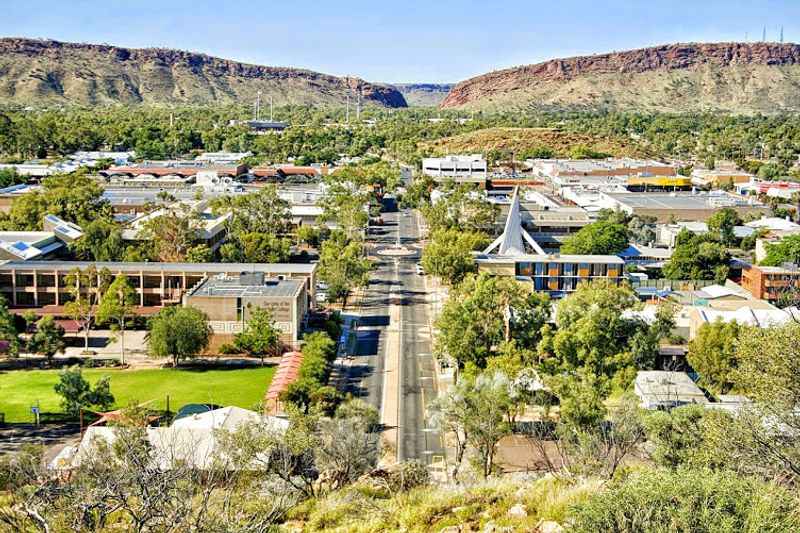
The heart of Australia's Red Centre, Alice Springs is a vibrant town rich in history and culture.
Visit the Alice Springs Desert Park to learn about the desert environment or explore the many art galleries showcasing Indigenous art. It's also the gateway to many outback adventures.
Kings Canyon

Located within Watarrka National Park, Kings Canyon features ancient sandstone walls, towering at over 100 meters.
The Rim Walk reveals stunning views of the Garden of Eden, a lush, waterhole-fed oasis, and the Lost City, known for its weathered rock formations resembling ancient ruins.
Final Thoughts: Experiencing Uluru Kata Tjuta National Park
Final Thoughts
Uluṟu's majestic presence and the sacred stories embedded in its landscape invite reflection and connection, offering insights not just into the land, but into ourselves.
I encourage you to visit this remarkable place, to witness its awe-inspiring beauty and immerse yourself in its ancient culture.
As you do, remember to respect the cultural significance and natural sanctity of Uluṟu.
For more information relating to Australia's National Parks and the history of its Indigenous people, see Tourism Australia and Tourism NT.
Wintjiri Wiru Acknowledgement:
As custodians of the land, Anangu holds the Mala story from Kaltukatjara to Uluru. To share their story, RAMUS designed and produced an artistic platform using drones, light and sound to create an immersive storytelling experience.







